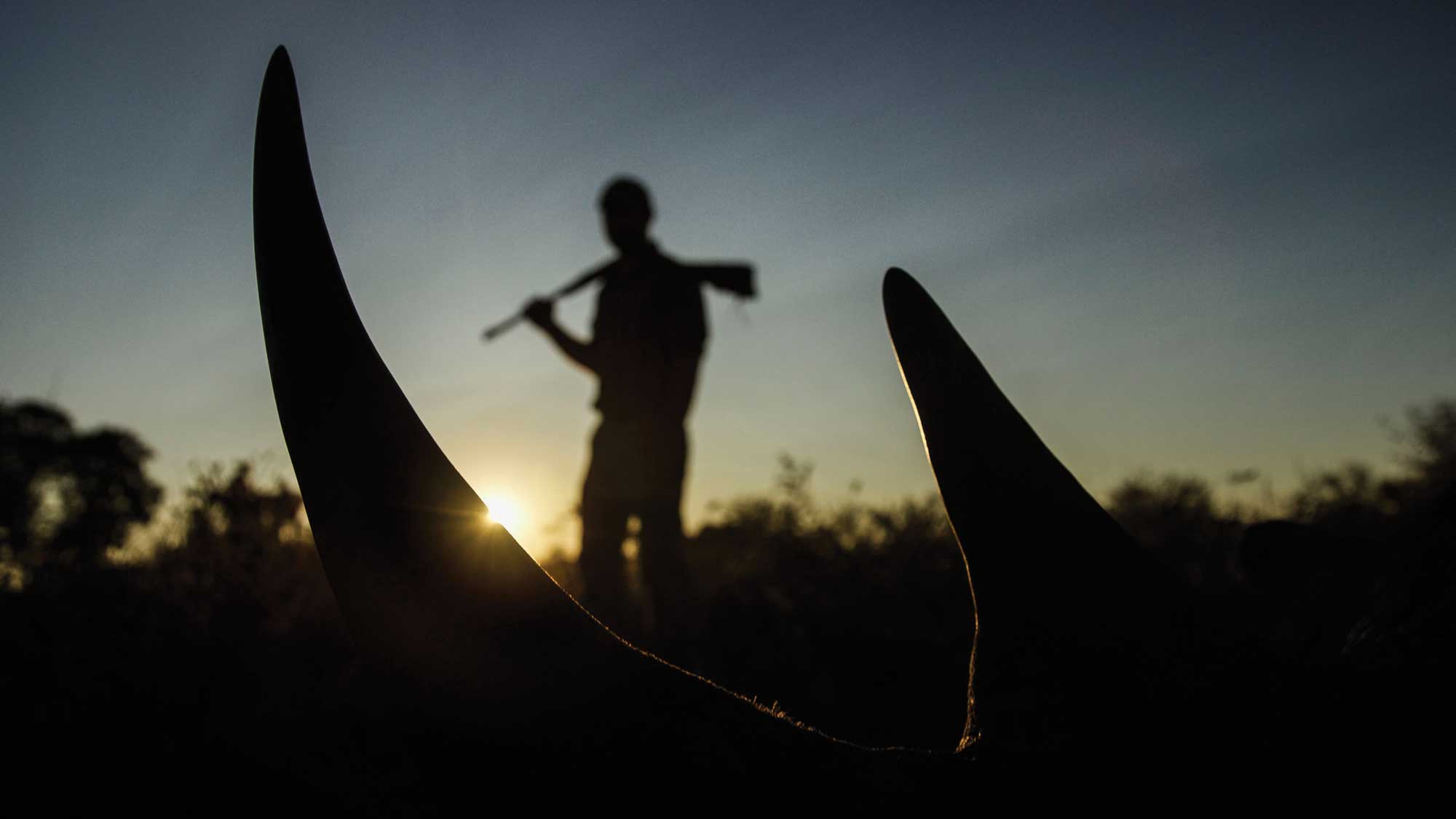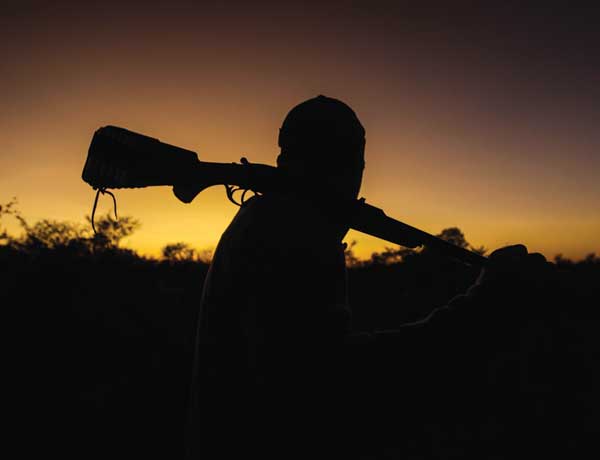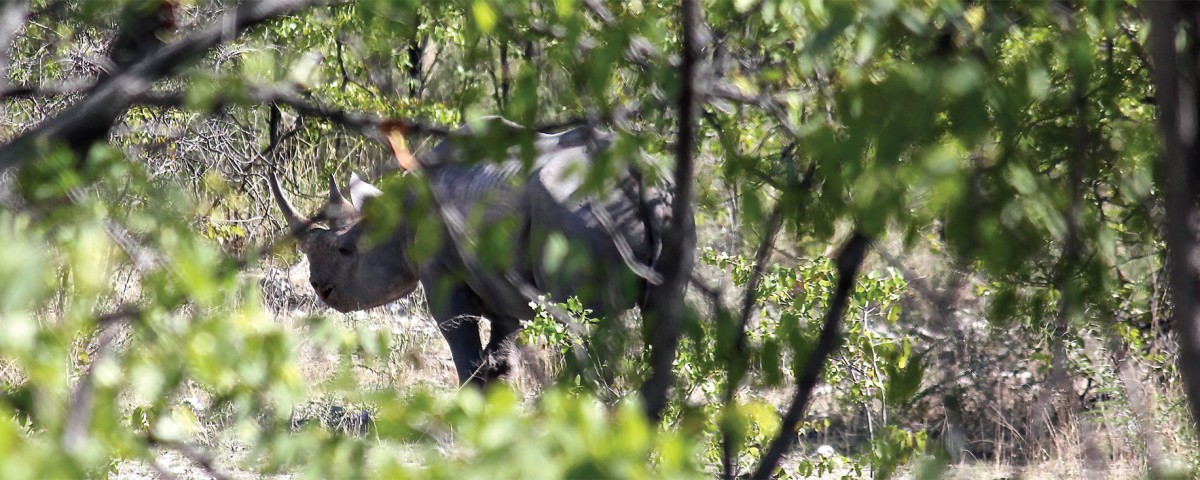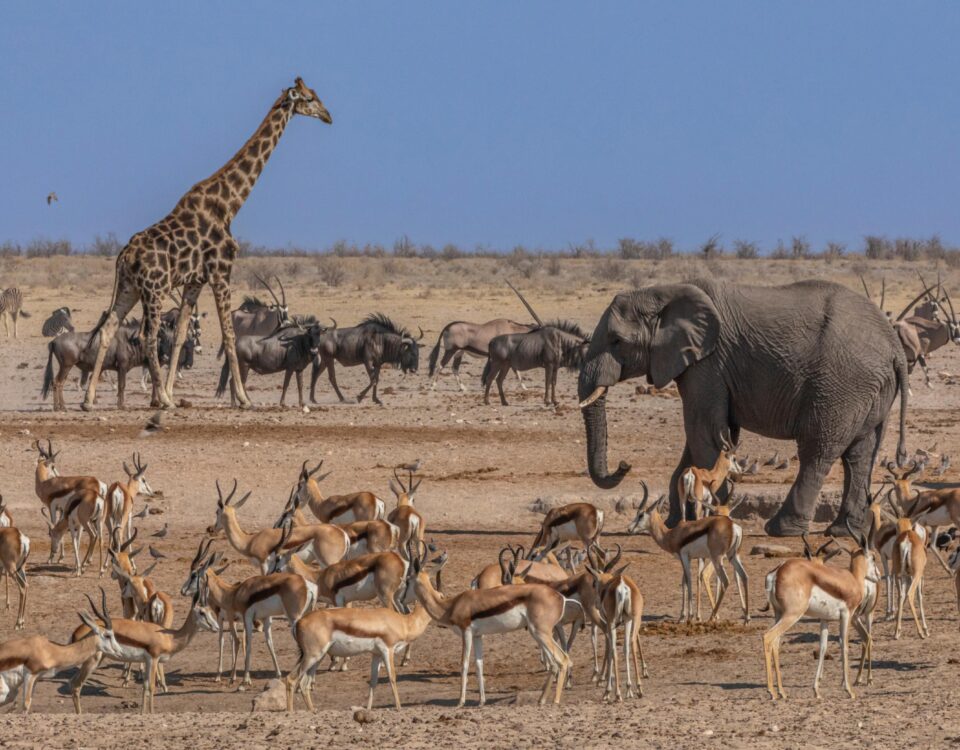” This was the hardest hunt of my life. They say you hunt elephant with your feet, buffalo with guts, leopard with your brain, but the most important of all is experience. “

Kaokoland – Stark and hostile
April 14, 2016The black rhino is the one animal few hunters have had the honour to hunt. In 2004 CITES granted Namibia a quota to offer past-productive males for a trophy hunt, but since then only six were taken. PH Hentie van Heerden was the lucky one chosen to guide Corey Knowlen on his hunting adventure in Namibia, to hunt the black rhino he had bought at an auction in Dallas, Texas. Here is his story.
I had no prior experience of rhino hunting. So I just had to use the combined experience that I have gained over all the years of stalking and outwitting trophy animals. This hunt was not straightforward at all. The Ministry of Environment and Tourism (MET) identified three potential males in two different areas. To make sure that we’d take the right animal two rangers of the Ministry had to accompany the hunter, myself and two trackers. And on top of that, a CNN photographer and journalist joined the hunting party to document the adventure. Not the ideal situation for any hunt, anywhere.
The first day of the hunt started as usual. Find the tracks. When the game ranger said, ‘yes it is the right one’, we started out on the spoor. But easier said than done. After walking in 40-degree heat, through soft sand and thick vegetation until two in the afternoon, and again the same story the following day, I decided that this was going to be too dangerous with such a big hunting party. This hunt was not going to be an ordinary one and there was no margin of error. The black rhino in this area do not sleep in the heat of the day like they do in other areas. Here they lie or stand in the shade of a tree, but when they hear something approach, or if they smell something odd, they get up and storm through the brush and keep running.

We informed MET that we were packing up, moving to the other identified area where the landscape is more forgiving, the vegetation sparser and the visibility better.
Two hours into the six-hour journey I received a call from the Ministry to say that they had located the identified animal in the area we were heading to, but it had died two weeks earlier, of natural causes associated with age, the horns still intact. So we turned back to square one.
The next day we start out early. Find the right spoor and start walking. We walk and walk because we know that at some point we will see him. MET confirmed it was the one, and we keep following the track.
It is not like on an elephant hunt where you at least see the animal towering above the tall grass. If like now, the grass is tall and the vegetation thick, you just don’t see him. He runs away from the noise. Then turns downwind and walks back in a half-circle (like a fish hook). You don’t know when he will make the loop, because you concentrate on following the spoor. The first you know he has looped is when you hear the 1.5-ton animal storm through the brush and run. That is when you realise you have passed him and he either heard you or got your smell. Rhino have very bad eyesight, but can hear extremely well and their sense of smell must also be very well developed.
You continue to follow the track and do the loop and find where he has rested and jumped up to storm off. And you keep on the track. The vegetation is so dense that it is impossible to see the animal when it is lying down. You cannot see further than 20-30 metres. You walk almost shoulder high in the tall grass, because the veld has not burnt yet.
” It is four o’clock in the afternoon and it is hot. We are even more tired and thirsty and our concentration is not what it should be. When you hunt big game it is at this point that you turn back and continue the next day. ”

You follow him through candle thorn, and umbrella thorn. Although the wind is in our favour, he outsmarts us twice. We follow the track and do not even hear him getting up and running on.
The sand is soft and we trudge on for kilometre after kilometre. It’s hot. And I know we have only today. Tomorrow he will have more tricks. We must just soldier on. He will get up and run and get up and run, until he gets tired. We must push him to get up sooner and as he gets tired he will run shorter stretches.
You don’t walk on animal paths. You just walk on the spoor and sometimes when he goes straight through a bush you have to go through that bush, too. Sometimes you see where he pauses, when he goes slowly. Where he moves from one shady spot to another. You realise that he is restless.
We are cautious now, because occasionally he just stops and looks back. He knows he is being followed and not by something that is giving up.
It is two hours after we left the rest of the hunting party behind. It is hot and we are thirsty. But now is not the time to give up. The cameraman discovers that his battery is flat, because he never switched it off, in case of unexpected action. Now we have to retrace our steps back to the group, where the spare batteries are.
We did not realise that just there, where we turned back, the old male heard us, got up and ran again.
Back with the group it was decision time. Do we turn back now, or continue? We are tired and thirsty. The heat of the day bears down on us and the vehicle is hours of walking from where we are.
I know that if we turn back now we have to start all over again tomorrow. And then this one will be even more cunning. We disturbed him all day. Just when he wanted to doze off, we bothered him and he had to get up and run. Earlier in the day he had run up to five kilometres before stopping. Now his running was down to 600m. He is definitely getting tired. We must push on.
We notice that he is walking zigzag. We must push harder. He knows we are behind him. Careful now. We leave the rest of the group behind. Just me and the hunter move forward cautiously. Twenty metres further we lose the spoor, because he zigzags. We spread out to find it again.
It is four o’clock in the afternoon and it is hot. We are even more tired and thirsty and our concentration is not what it should be. When you hunt big game it is at this point that you turn back and continue the next day.
At that moment I hear branches breaking and I hear him snort. Forty metres to the right he comes crashing through the bush. I turn around and shout “take him”, but there is a bush between the hunter and the rhino. The rhino charges the tracker, who is experienced enough to freeze.
After a few metres the rhino turns and trots off.
Our knees are shaking as we all gather from different directions. We have to go on now. He is angry and I don’t know how he will react, so we must all stay together.
A hundred metres further on, we find the spoor again and we realise that he is going slowly again.


As a big game hunter you gain experience of animals that can hurt you if you are ignorant – elephant, buffalo, lion, leopard, gemsbok. You get a feeling for what reaction to expect. It is as if you start to ‘think’ like them. But my years of experience do not include this one. When he slows down again and starts to zigzag, I tell the rest of the group to stop. The wind is in our favour. We are going to meet up. I just have that feeling. Fifty metres on and one of the group staying behind walks up to us to take a photograph. I hear a panicked scream and turn around just in time to see how the photographer runs towards us edgeways and over his shoulder I see the rhino in full charge. I shout “get out of the way” and he dives into the sand as the first two shots ring out.
Of course this old male did exactly what he did all day. Made a loop, stood under a tree and waited for us to back off. He must have known that what he heard was not the familiar sounds of the bush. Not an eland or gemsbok trotting through the brush. It could also be that he was familiar with the rangers on patrol. They checked to see if it is him, made an entry and left. This time, they did not back off. Standing under a tree in the shade he must have seen figures moving across an opening and then he charged.
The first shot was from the side. An open shot. But with the second there was a bush blocking the view. I heard the bullet hit, but could not see where, because there was not enough dust on the rhino’s skin to show and the sun was blurring my sight slightly. We know he was hit, but we did not hear him fall. We waited for about 15 minutes, checked our rifles and then followed his spoor again. We crossed an opening, with one tall tree and thick brush on the side. Here the rhino turned and turned and stamped several times. But no blood on the spoor. The tracker spotted him from the tree at 60 metres in a bush to our right, perfect for a fatal shot behind the shoulder.
ROAD TO SUCCESS
By the 1980s, ninety percent of the global rhino population was extinct, and on the IUCN Red Data List of Endangered Species rhinos were listed as critically endangered. For the past 30 years, dedicated individuals involved local communities in the northwest of Namibia to counter poaching by forming conservation groups, developing tactics and by relevant training. Today Namibia is home to the largest free-roaming black rhino population in the world. So successful have the efforts of Government, local communities, NGOs and civil society been, that Namibia is the only country in the world where black rhinos, among many other species, are re-located from national parks to private game reserves and communal land.
In 1998, underpinned by Clause 95 (1) of our Constitution, Communal Areas Conservancies were established, giving rural Namibians living on that land the legal right and responsibility to manage their natural resources themselves. There are currently 82 such conservancies covering 161,000 km2. The Community Based Natural Resource Management Programme provides the management tools and support for these conservancies to use their natural resources sustainably. In the early days many of the conservancies depended on donors, but over the years they have become independent thanks to joint-ventures lodges and trophy hunting. The latest official statistics for 2014 show that the sustainable use of wildlife generated over N$32 million in total benefits (meat, employment and cash), the majority of which came from trophy hunting. Operators made cash payments of more than N$26 million to conservancies for 48 hunting concessions. The remaining N$9.9 million are predominantly from meat sales and employment income.


